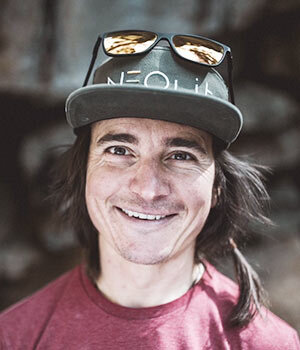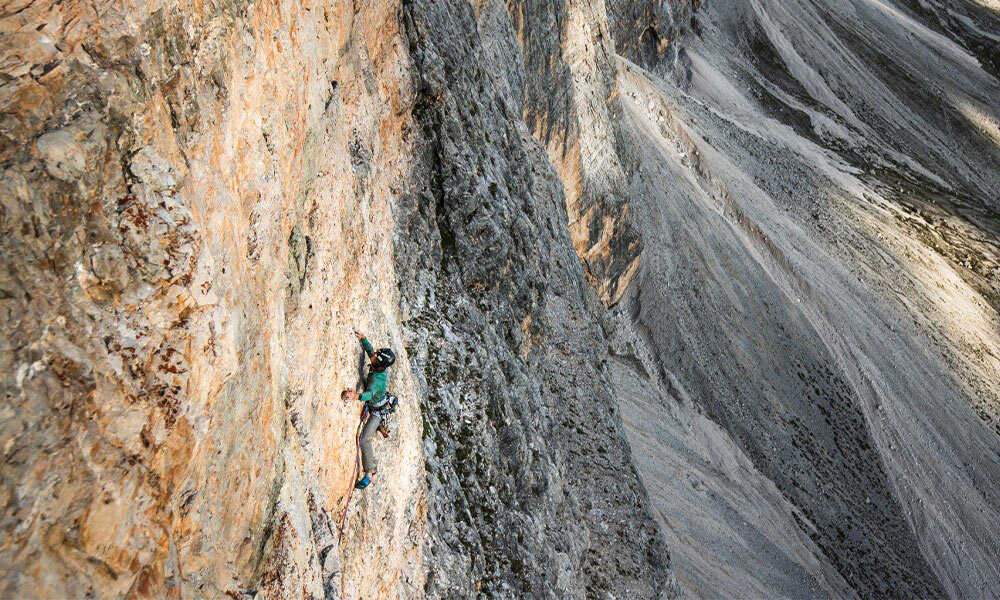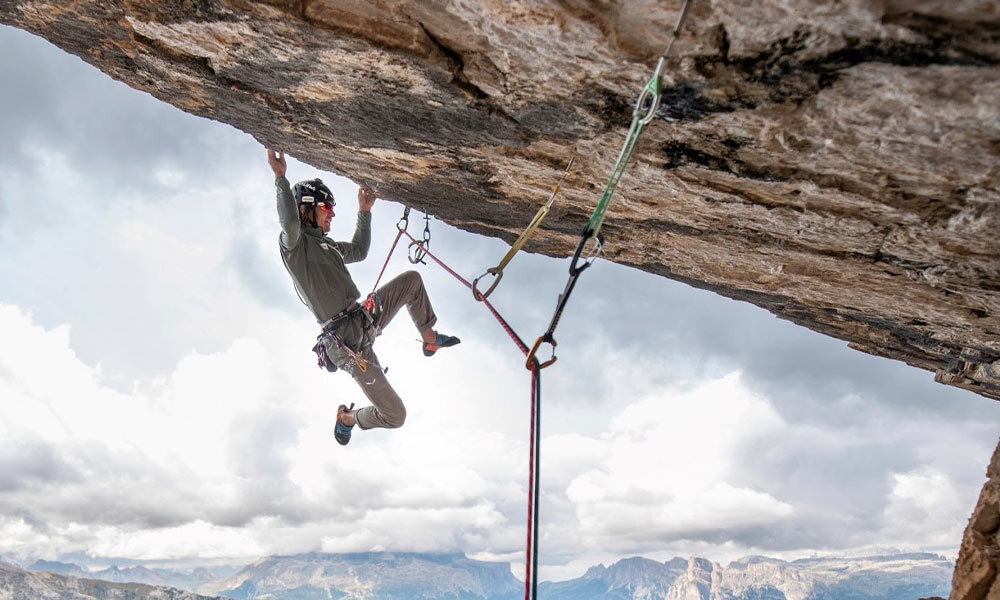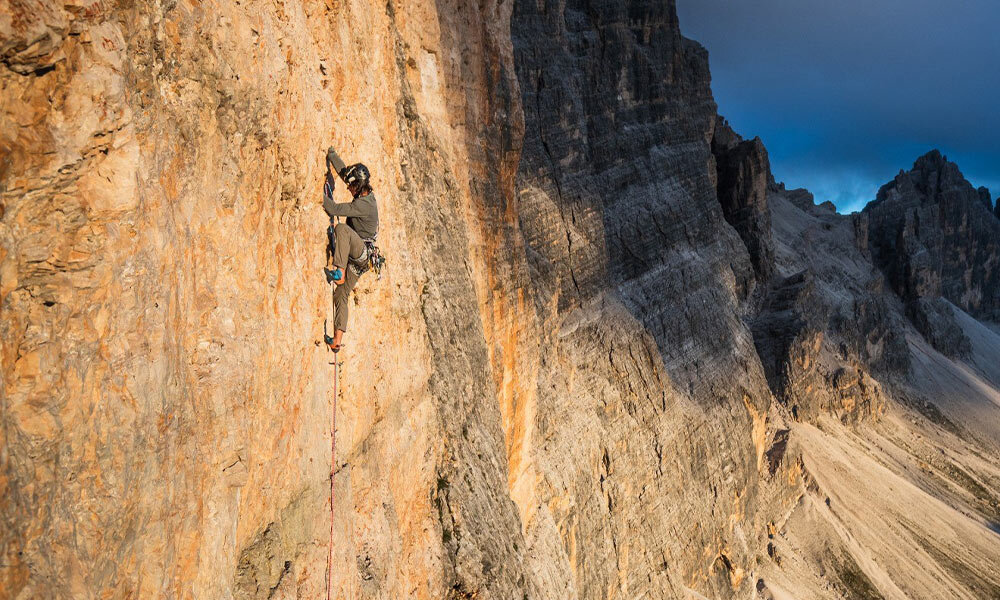- First ascent 2017 “Shiva’s Ice” M6 Wi5 1500m Shivling Indien with Vittorio Messini
- Solo First Ascent 2018 “Can you hear me” 10- 550m (without Bohrhaken) Cima Scotoni Dolomiten
Career Highlights
-
NonStop ascent 2014 „Supercanaleta“ Fiz Roy in 32,5 Stunden (Tal-Gipfel-Tal) with Gerry Fiegl
- First Ascent 2015 “Black rose” 6c/A1 M4 1000m | Devils Paw Alaska with Roger Schäli
- First ascent 2017 “Stigmata” 10-/10 300m (without Bohrhaken) Heiligkreuzkofel Dolomiten with Andrea Oberbacher

- North6 with Roger Schäli 2021 Zinnen Nordwand, Badile Nordwand, Eiger Nordwand ,Matterhorn Nordwand, DrùNordwand, Grandejorasses Nordwand in 17 days Bicycles and paragliders were used to get around
- Erste Wintersolo Traverse the entire Rosengarten in 3 days max 6- 5000hm 17 km 2022.
Interview
-
Climbing
When and how did you get into climbing? What keeps you interested? What fascinates you?
Relatively late in the late summer of 2001 at the rather advanced age of 18. Near the Three Peaks, an elderly gentleman took me in his car and told me about his heroic ascent of the Grand Peaks. At the same time he told me that sport climbing was only for softies and that alpine climbing would make a real man out of you. This triggered a great curiosity and fascination in me. A short time later, my brother and I started climbing together with our group of friends. I had always been active in sports before, but no sport captivated me as much as climbing. The first time I felt an incredible fire in me and this burned absofort only for climbing.
Who was your childhood hero and do you consider yourself a role model now? Does it influence you at all that other people look up to you?
There are several generations of pioneers who have left lasting traces in the Dolomites as well as with me. After the free climbing legends (e.g. Preuss) of the early years of the 20th century and the climbing icons of the 1930s (e.g. Comici), I am particularly inspired by the first ascents of the young Reinhold Messner and the daring classically secured routes of the South Tyrolean climbing guild around Roland Mittersteiner and Hanspeter Eisendle of the 1980s and early 1990s. Their foresight, courage and creativity have decisively influenced and shaped me. Likewise, the daring lines and style of a Christoph Hainz stand out. Especially until the mid 90's he opened some daring routes whose style influenced me significantly. Even if you have become a role model yourself, I am always aware that you also bear a great responsibility and can, to a certain extent, be decisive for the development of younger climbers. That's why it's important to me to be and remain credible, reliable and authentic.
What were your greatest failures / setbacks / injuries? How did you cope with them and how did you come back from them?
Fortunately, I have been exempt from major injuries so far. A rather dramatic gastrointestinal surgery in 2006 I was able to put away relatively quickly and train myself back into a peak of form in a short time. However, there were also several mental setbacks and dampers, such as the tragic accident of my good friend Gerry. In such cases, I am glad to be well supported by my family and close friends.
What is your favourite climbing-related story / experience?
Self-confidence and self-assurance are two essential qualities in the mountains that a climber should radiate. However, the fine line between self-overestimation and overconfidence is very sharp and must always be taken into account. My own skills and the experience I have gained over many years on the various rock faces of the world form the framework within which I can move responsibly. As the first great free climbing pioneer Paul Preuss said at the beginning of the 20th century: "The skill is the measure of the ability".
-
Training
Do you have a strict training schedule for when and how you train throughout the year?
If I have a project in mind, I can devote myself to it with full focus and concentration. Of course, this also includes goal-oriented training, which corresponds to the basic principles of training theory and can and must vary depending on the nature of the project or route.
What advice can you give to others looking to improve their training routine?
Look for and pay attention to the "noble" mix between loads and recovery and let motivation take a proper space of the training. Visualize your goals carefully and try to enjoy even the toughest training sessions.
What do you think of indoor climbing gyms in relation to climbing on actual rock?
Super fitness training and endurance training. The social aspect is not neglected either. Climbing on real rock is much more authentic and the movements there also feel much more natural and free.
How much of success as a pro climber is due to self-marketing and how much due to actual climbing skill?
No - unfortunately I have to pass on both exercises.
-
Psychology
Can anyone train to be able to do a one-armed pull-up or reach the summit of the Eiger/Matterhorn? Or do you have to be born for it?
Of course, genes and a certain amount of talent are decisive and essential. But I think the even bigger part of a successful project is the possibility to motivate yourself and a huge portion of passion.
How important is it to set goals in professional sports? What are your goals? What targets are you working towards for your climbing and in life?
The most important thing is to have projects and goals to work towards. In this way, a flame always blazes and burns inside me for my favorites and my great passion, alpine climbing in all its facets.
Focus and concentration must be in harmony and the targeted project must also have realistic dimensions. If it should not go nevertheless, although I could give my very best, I am reasonable enough to be able to realize that the time was perhaps not yet ripe or also external circumstances prevented the success. Being desperate and frustrated can never be the solution to the problem.
-
Future of climbing
Is there anything you would like to change about current developments in climbing?
In every field of climbing, an incredible level is climbed in the meantime. Whether on icefalls, alpine walls or even on artificial walls. The level and density are impressive. The development will continue and the new generation will always stand on the shoulders of the older generation. For me personally, it is important to constantly have new and for me personally appealing ideas to create projects with a strong character.





